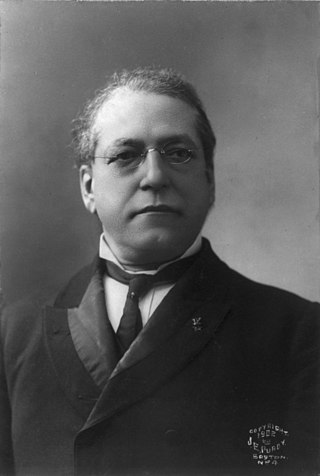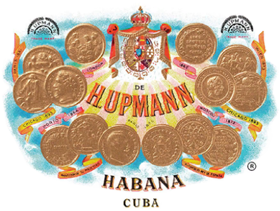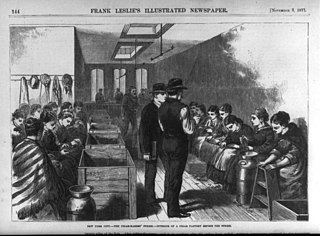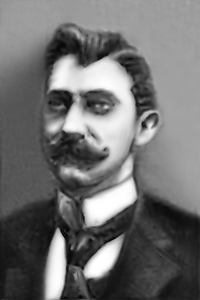
The United Auto Workers (UAW), fully named International Union, United Automobile, Aerospace and Agricultural Implement Workers of America, is an American labor union that represents workers in the United States and southern Ontario, Canada. It was founded as part of the Congress of Industrial Organizations (CIO) in the 1930s and grew rapidly from 1936 to the 1950s. The union played a major role in the liberal wing of the Democratic Party under the leadership of Walter Reuther. It was known for gaining high wages and pensions for automotive manufacturing workers, but it was unable to unionize auto plants built by foreign-based car makers in the South after the 1970s, and it went into a steady decline in membership; reasons for this included increased automation, decreased use of labor, mismanagement, movements of manufacturing, and increased globalization. After a successful strike at the Big Three in 2023, the union organized its first foreign plant (VW) in 2024.

Samuel Gompers was a British-born American cigar maker, labor union leader and a key figure in American labor history. Gompers founded the American Federation of Labor (AFL) and served as the organization's president from 1886 to 1894, and from 1895 until his death in 1924. He promoted harmony among the different craft unions that comprised the AFL, trying to minimize jurisdictional battles. He promoted thorough organization and collective bargaining in order to secure shorter hours and higher wages, which he considered the essential first steps to emancipating labor.

The American Federation of Labor was a national federation of labor unions in the United States that continues today as the AFL–CIO. It was founded in Columbus, Ohio, in 1886 by an alliance of craft unions eager to provide mutual support and disappointed in the Knights of Labor. Samuel Gompers was elected the full-time president at its founding convention and was re-elected every year except one until his death in 1924. He became the major spokesperson for the union movement.

W.D. & H.O. Wills was a British tobacco manufacturing company formed in Bristol, England. It was the first British company to mass-produce cigarettes. It was one of the 13 founding companies of the Imperial Tobacco Company ; these firms became branches, or divisions, of the new combine and included John Player & Sons.
The Journeymen Cigar Makers' International Union of America (CMIU) was a labor union established in 1864 that represented workers in the cigar industry. The CMIU was part of the American Federation of Labor from 1887 until its merger in 1974.

H. Upmann is a Cuban brand of premium cigars established by banker Hermann Dietrich Upmann. The brand is currently owned by a British corporation, Imperial Brands. The cigars are manufactured by Habanos S.A., the state-owned tobacco company in Cuba, and Altadis in La Romana, Dominican Republic.

The Bakery, Confectionery, Tobacco Workers and Grain Millers International Union (BCTGM) is a labor union in the United States and Canada primarily representing workers in the food processing industry. The union was established in 1886 as the Journeyman Bakers Union. The contemporary BCTGM was formed in January 1999 as a merger of the Bakery, Confectionery and Tobacco Workers' International Union and the American Federation of Grain Millers.

The Ybor Factory Building is a historic site in Tampa, Florida, United States located at 1911 North 13th Street. The main factory and its surrounding support buildings cover an entire city block between 8th Avenue and 9th Avenues and 13th and 14th Streets in the Ybor City Historic District section of the Ybor City neighborhood. C. E. Parcell is credited as the building's architect.
Newsboy or news boy may refer to:
Churchman's was a British cigarette manufacturer based in Ipswich, Suffolk. The company was a subsidiary of John Player & Sons of Imperial Tobacco Co. Churchman was notable for producing one million cigarettes a day.

The Nicholas J. Kuhnen House is a historic building located in central Davenport, Iowa, United States. It has been listed on the National Register of Historic Places since 1983.

Frank Anthony Llaneza was a tobacco blender and former executive of Villazon & Co. who is regarded as a pioneer in the resurgence of the premium cigar industry at the end of the 20th Century. Llaneza is best known for the creation and manufacture of a number of popular cigar brands in the years after the 1962 Cuban Embargo, including Hoyo de Monterrey, Punch, Bolivar, and Siglo.

The Ybor cigar makers' strike of 1931 took place in Ybor City, Tampa, Florida, starting on November 26 and ended in December. Some strikers were jailed, "Lectors" were banned and there was a lockout. Following legal intervention, some workers returned to work at previous wage levels but others were not re-employed. Lectors had by tradition been elected by the workers and, as well as reading aloud newspaper articles, often from left-wing radical publications, they recited and acted more generally, including from classic works – effectively they provided a form of education for illiterate workers. The most significant effect of the strike in the longer term was that the lector culture was brought to an end.

Waitt & Bond, Inc. was an American cigar manufacturer that was in operation from 1870 to 1969. During the early 20th century it was the largest cigar manufacturer in New England and one of the largest in the United States.

A newspaper hawker, newsboy or newsie is a street vendor of newspapers without a fixed newsstand. Related jobs included paperboy, delivering newspapers to subscribers, and news butcher, selling papers on trains. Adults who sold newspapers from fixed newsstands were called newsdealers, and are not covered here. The hawkers sold only one newspaper, which usually appeared in several editions a day. A busy corner would have several hawkers, each representing one of the major newspapers. They might carry a poster board with giant headlines, provided by the newspaper. The downtown newsboy started fading out after 1920 when publishers began to emphasize home delivery. Teenage newsboys delivered papers on a daily basis for subscribers who paid them monthly. Hawkers typically purchased a bundle of 100 copies from a wholesaler, who in turn purchased them from the publisher. Legally every state considered the newsboys to be independent contractors, and not employees, so they generally were not subject to child labor laws.

The cigar makers' strike of New York lasted from mid-October 1877 until mid-February 1878. Ten thousand workers walked out at the height of the strike, demanding better wages, shorter hours and better working conditions, especially in the tenement manufacturing locations. The strike was supported by the Cigar Makers International Union of America, local chapter 144.
On July 7, 1919, roughly 2,100 of Boston's 2,400 cigar makers walked off the job in protest of their employer's failure to meet their demand of a 13 7/11% raise. Three of Boston's largest cigar manufacturers chose to leave the city rather than meet the union's demands and a number of union members formed a cigar-making co-operative. By August 30, 1919, all of the remaining manufacturers had reached agreements with the union.

Frederick H. Copenspire (1868–1908) was a Washington State pioneer, politician, and businessman who lived in South Bend. Copenspire was one of the first Pacific County assessors, and one of the few Democrats elected to this position at a time of Republican popularity. Copenspire also served as mayor of South Bend for several years. His house was added to the list of the landmarks in the city's historic tour.
The 1913 Studebaker strike was a labor strike involving workers for the American car manufacturer Studebaker in Detroit. The six-day June 1913 strike, organized by the Industrial Workers of the World (IWW), is considered the first major labor strike in the automotive industry.
The 1945–1946 Charleston Cigar Factory strike was a labor strike involving workers at the Cigar Factory in Charleston, South Carolina, United States. The strike commenced on October 22, 1945, and ended on April 1 of the following year, with the strikers winning some concessions from the company.

















